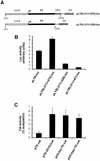An interferon regulatory factor binding site in the U5 region of the bovine leukemia virus long terminal repeat stimulates Tax-independent gene expression
- PMID: 9621009
- PMCID: PMC110197
- DOI: 10.1128/JVI.72.7.5526-5534.1998
An interferon regulatory factor binding site in the U5 region of the bovine leukemia virus long terminal repeat stimulates Tax-independent gene expression
Abstract
Bovine leukemia virus (BLV) replication is controlled by both cis- and trans-acting elements. The virus-encoded transactivator, Tax, is necessary for efficient transcription from the BLV promoter, although it is not present during the early stages of infection. Therefore, sequences that control Tax-independent transcription must play an important role in the initiation of viral gene expression. This study demonstrates that the R-U5 sequence of BLV stimulates Tax-independent reporter gene expression directed by the BLV promoter. R-U5 was also stimulatory when inserted immediately downstream from the transcription initiation site of a heterologous promoter. Progressive deletion analysis of this region revealed that a 46-bp element corresponding to the 5' half of U5 is principally responsible for the stimulation. This element exhibited enhancer activity when inserted upstream or downstream from the herpes simplex virus thymidine kinase promoter. This enhancer contains a binding site for the interferon regulatory factors IRF-1 and IRF-2. A 3-bp mutation that destroys the IRF recognition site caused a twofold decrease in Tax-independent BLV long terminal repeat-driven gene expression. These observations suggest that the IRF binding site in the U5 region of BLV plays a role in the initiation of virus replication.
Figures





Similar articles
-
Regulation of Expression and Latency in BLV and HTLV.Viruses. 2020 Sep 25;12(10):1079. doi: 10.3390/v12101079. Viruses. 2020. PMID: 32992917 Free PMC article. Review.
-
Suboptimal enhancer sequences are required for efficient bovine leukemia virus propagation in vivo: implications for viral latency.J Virol. 2001 Aug;75(15):6977-88. doi: 10.1128/JVI.75.15.6977-6988.2001. J Virol. 2001. PMID: 11435578 Free PMC article.
-
Upstream stimulatory factors binding to an E box motif in the R region of the bovine leukemia virus long terminal repeat stimulates viral gene expression.J Biol Chem. 2002 Mar 15;277(11):8775-89. doi: 10.1074/jbc.M107441200. Epub 2001 Dec 10. J Biol Chem. 2002. PMID: 11741930
-
Two elements in the bovine leukemia virus long terminal repeat that regulate gene expression.Science. 1986 Mar 21;231(4744):1437-40. doi: 10.1126/science.3006241. Science. 1986. PMID: 3006241
-
IRF regulation of HIV-1 long terminal repeat activity.J Interferon Cytokine Res. 2002 Jan;22(1):27-37. doi: 10.1089/107999002753452638. J Interferon Cytokine Res. 2002. PMID: 11846973 Review.
Cited by
-
MicroRNAs Encoded by Bovine Leukemia Virus (BLV) Are Associated with Reduced Expression of B Cell Transcriptional Regulators in Dairy Cattle Naturally Infected with BLV.Front Vet Sci. 2018 Jan 15;4:245. doi: 10.3389/fvets.2017.00245. eCollection 2017. Front Vet Sci. 2018. PMID: 29379791 Free PMC article.
-
Regulation of Expression and Latency in BLV and HTLV.Viruses. 2020 Sep 25;12(10):1079. doi: 10.3390/v12101079. Viruses. 2020. PMID: 32992917 Free PMC article. Review.
-
A detailed molecular analysis of complete bovine leukemia virus genomes isolated from B-cell lymphosarcomas.Vet Res. 2013 Mar 18;44(1):19. doi: 10.1186/1297-9716-44-19. Vet Res. 2013. PMID: 23506507 Free PMC article.
-
Role of the cellular factor CTCF in the regulation of bovine leukemia virus latency and three-dimensional chromatin organization.Nucleic Acids Res. 2022 Apr 8;50(6):3190-3202. doi: 10.1093/nar/gkac107. Nucleic Acids Res. 2022. PMID: 35234910 Free PMC article.
-
Suboptimal enhancer sequences are required for efficient bovine leukemia virus propagation in vivo: implications for viral latency.J Virol. 2001 Aug;75(15):6977-88. doi: 10.1128/JVI.75.15.6977-6988.2001. J Virol. 2001. PMID: 11435578 Free PMC article.
References
-
- Boshart M, Klüppel M, Schmidt A, Schütz G, Luckow B. Reporter constructs with low background activity utilizing the cat gene. Gene. 1992;110:129–130. - PubMed
-
- Bovolenta C, Driggers P H, Marks M S, Medin J A, Politis A D, Vogel S N, Levy D E, Sakaguchi K, Appella E, Coligan J E, Ozato K. Molecular interactions between interferon consensus sequence binding protein and members of the interferon regulatory factor family. Proc Natl Acad Sci USA. 1994;91:5046–5050. - PMC - PubMed
Publication types
MeSH terms
Substances
LinkOut - more resources
Full Text Sources
Other Literature Sources

